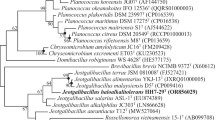Abstract
A Gram-stain-negative, catalase- and oxidase-positive, rod-shaped bacterium, designated as JK6T was isolated from a coastal marine sediment in Jeju Island. Strain JK6T was characterized by polyphasic investigation including genome features. It grew at pH 5.0–9.0 (optimum 7.5), 18–30 °C (optimum 25 °C) and 1.0–7.0% (w/v) NaCl (optimum 2.0%). Strain JK6T utilized d-mannose, d-glucose, l-fucose, propionate and acetate as carbon and energy sources. The sole quinone was ubiquinone-10, and the major polar lipids were diphosphatidylglycerol, phosphatidylglycerol, phosphatidylethanolamine, phosphatidylcholine, and sphingolipid. Strain JK6T was closely related to Parasphingorhabdus flavimaris SW-151T (98.2%), Parasphingorhabdus marina DSM 22363T (97.6%) and Parasphingorhabdus litoris FR1093T (97.6%) based on 16S rRNA gene sequence similarity. Genome length and GC content were 3.29 Mbp and 53.0%, respectively. Digital DNA-DNA relatedness, average nucleotide identity, and average amino acid identity between strain JK6T and P. flavimaris SW-151T were 16.6%, 73.9%, and 77.6%, respectively. These results showed that the strain can be recognized as a novel bacterium named Parasphingorhabdus halotolerans. The type strain of Parasphingorhabdus halotolerans sp. nov. is JK6T (= KCTC 72818T = VTCC 910111T).

Similar content being viewed by others
Availability of data and material
The GenBank/EMBL/DDBJ accession number for the 16S rRNA gene sequence and the complete genome of strain JK6T is MK905445 and CP051217.
References
Chin CS, Alexander DH, Marks P, Klammer AA, Drake J et al (2013) Nonhybrid, finished microbial genome assemblies from long-read SMRT sequencing data. Nat Methods 10:563–569
Feng GD, Zhang XJ, Yang SZ, Li AZ, Yao Q et al (2020) Transfer of Sphingorhabdus marina, Sphingorhabdus litoris, Sphingorhabdus flavimaris and Sphingorhabdus pacifica corrig. into the novel genus Parasphingorhabdus gen. nov. and Sphingopyxis baekryungensis into the novel genus Novosphingopyxis gen. nov. within the family Sphingomonadaceae. Int J Syst Evol Microbiol 70:2147–2154
Galperin MY, Kristensen DM, Makarova KS, Wolf YI, Koonin EV (2019) Microbial genome analysis: the COG approach. Brief Bioinform 20:1063–1070
Griess-Romijn van Eck E (1966) Physiological and chemical tests for drinking water. NEN 504:1056
Hall TA (2004) BioEdit: a user-friendly biological sequence alignment editor and analysis program for windows 95/98/NT. Nucleic Acids Symp Ser 41:95–98
Kim BS, Lim YW, Chun J (2008) Sphingopyxis marina sp. nov. and Sphingopyxis litoris sp. nov., isolated from seawater. Int J Syst Evol Microbiol 58:2415–2419
Kim M, Cha IT, Lee KE, Lee BH, Park SJ (2021) Kineobactrum salinum sp. nov., isolated from marine sediment. Int J Syst Evol Microbiol 71
Koh HW, Rani S, Kim SJ, Moon E, Nam SW et al (2017) Halomonas aestuarii sp. nov., a moderately halophilic bacterium isolated from a tidal flat. Int J Syst Evol Microbiol 67:4298–4303
Konstantinidis KT, Ramette A, Tiedje JM (2006) The bacterial species definition in the genomic era. Philos Trans R Soc Lond B Biol Sci 361:1929–1940
Kumar S, Stecher G, Tamura K (2016) MEGA7: molecular evolutionary genetics analysis version 7.0 for bigger datasets. Mol Biol Evol 33:1870–1874
Lane D (1991) 16S/23S rRNA sequencing. In: Stackebrandt E, Goodfellow M (eds) Nucleic acid techniques in bacterial systematics. John Wiley and Sons, New York, pp 115–175
Meier-Kolthoff JP, Göker M (2019) TYGS is an automated high-throughput platform for state-of-the-art genome-based taxonomy. Nat Commun 10:1–10
Minnikin DE, Odonnell AG, Goodfellow M, Alderson G, Athalye M et al (1984) An integrated procedure for the extraction of bacterial isoprenoid quinones and polar lipids. J Microbiol Methods 2:233–241
Richter M, Rossello-Mora R, Oliver Glöckner F, Peplies J (2016) JSpeciesWS: a web server for prokaryotic species circumscription based on pairwise genome comparison. Bioinformatics 32:929–931
Ryu D, Kim M, Han B, Lee KE, Lee BH et al (2020) Ferrovibrio terrae sp. nov., isolated from soil. Int J Syst Evol Microbiol 70:1042–1047
Siddiqi MZ, Choi GM, Choi KD, Im WT (2017) Paenibacillus azotifigens sp. nov., a novel nitrogen-fixing bacterium isolated from paddy soil. Int J Syst Evol Microbiol 67:4917–4922
Tatusova T, DiCuccio M, Badretdin A, Chetvernin V, Nawrocki EP et al (2016) NCBI prokaryotic genome annotation pipeline. Nucleic Acids Res 44:6614–6624
Yoon JH, Oh TK (2005) Sphingopyxis flavimaris sp. nov., isolated from seawater of the Yellow Sea in Korea. Int J Syst Evol Microbiol 55:369–373
Yoon SH, Ha SM, Kwon S, Lim J, Kim Y et al (2017) Introducing EzBioCloud: a taxonomically united database of 16S rRNA gene sequences and whole-genome assemblies. Int J Syst Evol Microbiol 67:1613–1617
Funding
This work was supported by Grants from the National Research Foundation of Korea (No. 2020R1I1A3062110 to SJP) and the National Institute of Biological Resources funded by the Ministry of Environment (No. NIBR202102109 and NIBR202104104 to the SJP). This work was supported by the Basic Research Project of the Korea Institute of Geoscience and Mineral Resources (21–3412-1 to SJK).
Author information
Authors and Affiliations
Contributions
S-JK, MK and S-JP designed research; MK and S-JP performed research; S-JK, MK, K-EL and I-TC analyzed data; S-JK, MK and S-JP wrote the paper.
Corresponding author
Ethics declarations
Conflict of interest
The authors declare that there are no conflicts of interest.
Additional information
Communicated by Erko Stackebrandt.
Publisher's Note
Springer Nature remains neutral with regard to jurisdictional claims in published maps and institutional affiliations.
Supplementary Information
Below is the link to the electronic supplementary material.
Rights and permissions
About this article
Cite this article
Kim, SJ., Kim, M., Lee, KE. et al. Parasphingorhabdus halotolerans sp. nov. isolated from marine sediment in Jeju Island. Arch Microbiol 203, 3803–3809 (2021). https://doi.org/10.1007/s00203-021-02366-8
Received:
Revised:
Accepted:
Published:
Issue Date:
DOI: https://doi.org/10.1007/s00203-021-02366-8




